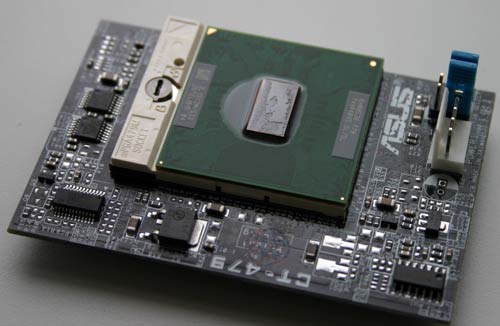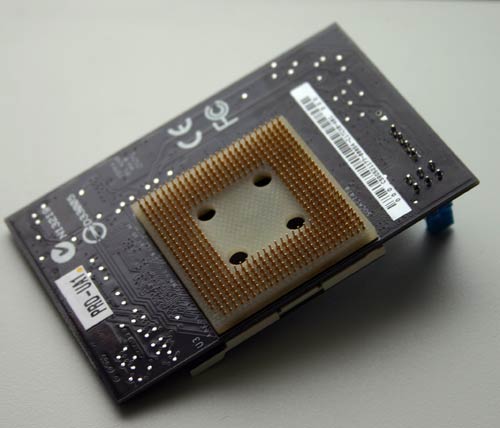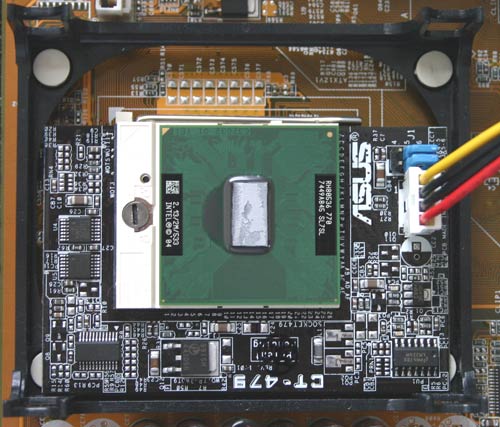Intel's Pentium M Desktop Part II: ASUS' Pentium M to Pentium 4 Socket Adapter
by Anand Lal Shimpi on March 24, 2005 1:31 PM EST- Posted in
- CPUs
ASUS CT-479: Socket-478 to Socket-479 Adapter
Enter the ASUS CT-479 CPU Upgrade Kit, an adapter board that will convert specific ASUS Socket-478 motherboards to support Pentium M CPUs. You will remember from our original Pentium M desktop article that the pinout of the Pentium M is different than the Pentium 4, although the two chips are electrically compatible (they use the same FSB). The next problem is that the Pentium M relies on a much lower voltage version of the Pentium 4's FSB, which is also addressed by ASUS' adapter, a problem that we did not think was solvable until now.
The CT-479 only works with ASUS motherboards, and only a limited number of them at that. Currently, only the ASUS P4P800-SE and P4P800-VM motherboards are supported, both of which are i865 based motherboards. ASUS is working on support for other boards; the P4C800-E (875P) will be supported soon. For our tests, we used a P4P800-SE; you need a BIOS update, but that's all. Obviously, non-ASUS motherboards are not supported; however, we're not certain whether or not the adapter can be made to work in other boards. We will be looking into this as time goes on, but we wanted to make sure that we could complete this article first before doing anything that would damage our setup.


The CT-479 supports all Pentium M and Celeron M CPUs (Dothan and Banias based) with the exception of the Low Voltage and Ultra Low Voltage versions.

The jumpers switch between 400 and 533MHz FSB settings. The power connector powers the adapter.
The CT-479 comes with the adapter board, heat sink/fan and power cable.

A perfect fit

The supplied heat sink is specifically made for the CT-479.
Currently, ASUS is listing the CT-479 as a part of a bundle with the P4P800-SE, priced at $130. At that price, the solution is almost half the price of the AOpen/DFI motherboards, and you get all of the benefits of the 865 chipset. The main benefit of the 865 chipset in this case is its dual channel DDR400 memory controller. The 533MHz FSB Pentium Ms are memory bandwidth starved by the 855GME's single channel DDR333 memory controller, so being paired with an 865 gives the CPU more memory bandwidth than it can use.
The P4P800-SE that we tested only allowed for 5:4 and 1:1 memory clock speed ratios, meaning that for our 533MHz FSB Pentium M, the maximum stock memory clock was DDR333. But since we're talking about a dual channel memory controller, even at DDR266 speeds, you have enough memory bandwidth for the processor - DDR400 support isn't necessary.
The other major benefit of the CT-479 is that you get to use a mature, mass-produced ASUS motherboard instead of a smaller production run, recently released 855GME solution. The benefits were clear in our testing - overclocking the Pentium M was far less of an ordeal on the ASUS solution.
The CT-479 does not support the Pentium M's SpeedStep technology, which has a handful of implications:
1) System power consumption will be higher on the ASUS solution than on 855GME based systems from AOpen/DFI. The reason being that the CPU will always run at maximum frequency, which is still lower power consumption than any other desktop processor, but it is worth mentioning.
2) You can't adjust the clock multiplier of the Pentium M like you can on the AOpen/DFI offerings. This will hamper the more adventurous overclockers, but it's definitely not a show stopper.
You also can't adjust the Pentium M's core voltage when using the CT-479; you're stuck at the default voltage. ASUS' Q-Fan technology (which allows for the automatic reduction of fan speed depending on thermal load) is supported, so you can reduce noise output even if SpeedStep isn't supported.
ASUS just announced the CT-479 last week, so there are some details that aren't yet available, such as whether or not the kit will be offered outside of the ASUS motherboard bundle. As soon as we have this information, we'll pass it along, but even if the only way to get it is with an ASUS motherboard, it is still a much better value than a standalone Pentium M motherboard.
The question here is how big of an impact does the 865 chipset have on the desktop performance of the Pentium M? To find out, we paired it with the Pentium M 770, Intel's fastest Pentium M running at 2.13GHz. The Pentium M 770 requires a 533MHz FSB, which is supported by the 865 chipset, and thus, is also supported by the CT-479 upgrade kit.
The Test
Our hardware configurations are similar to what we've used in previous comparisons.
AMD Athlon 64 Configuration
Socket-939 Athlon 64 CPUs
2 x 512MB OCZ PC3200 EL Dual Channel DIMMs 2-2-2-10
NVIDIA nForce4 Reference Motherboard
ATI Radeon X800 XT PCI Express
Intel Pentium 4 Configuration
LGA-775 Intel Pentium 4 and Extreme Edition CPUs
2 x 512MB Crucial DDR-II 533 Dual Channel DIMMs 3-3-3-12
Intel 925XE Motherboard
ATI Radeon X800 XT PCI Express
Intel Pentium M Configuration
Intel Pentium M 725 - 755
2 x 512MB OCZ PC3200 EL Dual Channel DIMMs 2-2-2-10
AOpen GMEm-LFS Motherboard
ASUS P4P800-SE + CT-479 Adapter
ATI Radeon X800 XT AGP










48 Comments
View All Comments
merkmal - Thursday, March 24, 2005 - link
I don't understand why there wasn't a direct comparison here between the i855 and the i865. It seems very un-anandtech like to go on and on about how this is such an improvment over the i855 setups and then not even show 2 of the same clocked processors in both setups to show if that really is the case. Testing a "faster" setup with a processor that is already known to be faster simply by the fact that it is clocked at stock speeds faster isn't a very good comparison or argument for better performance either.I understand the fact that lots of readers are interested in using a Pentium-M on the desktop and would like to know how it compares to other desktop processors, but I thought that was clear from the previous article on exactly that. This article should have been only Pentium-Ms in a variety of setups. It's easy to check back at the old article and see relatively how the new setup compares to the other desktop only processors.
I'm just very dissapointed in this article. I appauled you on the reviewing of the adapter, but think the comparisons drawn were just shoddy and un-thought out.
VIAN - Thursday, March 24, 2005 - link
Can't wait for Intel to do away with the P4 and step in with a suped-up PM.Or at least do away with the EE, market the PM as a multimedia chip and the P4 as a workstation chip.
kmmatney - Thursday, March 24, 2005 - link
NewEgg doesn't sell the 770 cpu, and it would be incredibly expensive if they did. Can you test the cheapest P-M, and see how it overclocks?PandaBear - Thursday, March 24, 2005 - link
Yeah PM is the way to go in the future. P4 architecture is getting way too inefficient and burn way too much power that it is not going to grow from where we are now. I am sure Intel is fully aware of this but keep it under the cover to avoid tanking the P4 sales. What would the customer think the PC they spend big bucks for is slower and hotter than a laptop CPU hacked from last generation technology, that would be a slap on the face.Anyhow, I still think A64 has better architecture for long term growth. Now if they come up with integrated North Bridge that has 20 PCIe lane in replacement of the HT port....
RockHydra11 - Thursday, March 24, 2005 - link
I don't understand the "desktop killer" thing...It never was intended for the desktop.It was centered to compete with anything else that was on the notebook platform, so Intel was not generating it to perform well against desktop processors, let alonre FLAGSHIP desktop processors. It is what it is, and that's that. Yonah is going to be the one centered toward real desktop performance.Mingon - Thursday, March 24, 2005 - link
Would have been nice to have run in both single and dual channel configs so as to see if the chip is bandwidth starved.68GTX - Thursday, March 24, 2005 - link
Looks like Legit reviews is currently testing with a new beta bios with voltage options."Part 2 is being updated... ASUS-USA sent me over a new BETA BIOS that is awesome. Fixes the performance issues and the voltage issues that were noted in the article... Take a look at the new voltages..."
http://forums.legitreviews.com/viewtopic.php?t=157...
Mangler - Thursday, March 24, 2005 - link
Legit Reviews also has this adapter reviewed today at: http://www.legitreviews.com/article.php?aid=181They compared an Intel 770 CPU on both the DFI 855GME-MGF motherboard and the ASUS P4P800SE for an apples to apples look. (i855GM versus i865PE)
They focus more on overclocking and use of the kit. A must read for any enthusiast.
Goi - Thursday, March 24, 2005 - link
#12, you can't say that tha Pentium M is based on old technology. There are many power saving techniques on the Pentium M that aren't implemented in the P4, both in the microarchitectural level, circuit level and logic level. The Pentium M is a hybrid between the P3 and the P4, but to say that it's closer to the P3, I'm not sure I agree with that. It does use executation units that are simialr to the P3's, but there are many areas where they are different, including the issue/control logic, which is a BIG part of microprocessors nowadays(and really, in the past decade or so).mrmorris - Thursday, March 24, 2005 - link
I'd like to point out that while the Pentium-M offer sub-desktop performance at worst, it does so with out heating up the room or requireing earplugs to dampen the fan noise! Therefore, as an office/coorporate workstation it fits perfect.